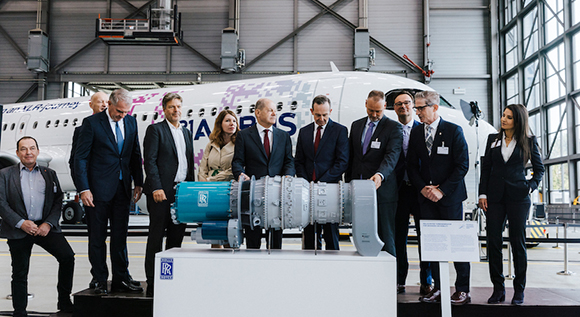Moving towards zero-emission flying
Mitigating climate change is an enormous technological challenge for aviation and shipping. However, new technologies, research and innovation can help provide zero-emissions solutions for air and water travel.
 © BMWK/ Julia Steinigeweg
© BMWK/ Julia Steinigeweg
Almost every plane we see in the sky uses components made by German suppliers. And one in six commercial aircraft is not only equipped with technology ‘made in Germany’, its final assembly also takes place here. Some 70% of Germany’s production is destined for export. This provides a powerful lever to make climate action an economic and industrial success story at the global scale.
The third National Aviation Conference, which took place on the premises of Lufthansa Technik in Hamburg this September, showcased many of the solutions that are to make zero-emission flying possible in the future. New propulsion systems, frugal engines and also lightweight materials can considerably increase efficiency. By 2050, the current level of carbon emissions in the aviation sector is to be reduced by up to 34%.
Third National Aviation Conference: presentation of a flying H2 test lab
The conference presented the German Aerospace Center’s flying H2 test lab, which has been financed from the budget of the German Aviation Research Programme (LuFo). It will allow SMEs and startups which do not have their own labs to conduct flight tests in order to test propulsion, fuel and systems technologies designed to reduce carbon emissions in aviation under real-life conditions. A video can be found here (German only).
“Climate technologies are key for international success in the aviation sector, and our export strength is a powerful lever to promote more climate action around the globe,” Federal Minister Habeck said before an audience of 400 participants at the conference. “I am delighted that some first successful projects such as the new flying H2 test lab have been showcased here in Hamburg today. We want to continue on our path towards transformation, together with all the stakeholders involved. This will make sure that Germany’s industry will have a future and that we can continue to create added value and employment in our country.”
Germany is advocating high environmental standards in aviation, including at international level. The EU has recently introduced mandatory quotas for sustainable aviation fuel; they will rise to 70% by 2050.
The first specific measures to meet this target were presented by the ‘climate-neutral aviation working group’ (made up of representatives from industry, professional associations, research, civil society and the trade unions) at the National Aviation Conference. They can be found here (German only). The measures include the retrofitting of aircraft with ‘shark skin’ – a synthetic surface material imitating actual shark skin which helps reduce aircraft friction drag –, the introduction of wash processes for condensers which help engines stay efficient, and the use of electronic approach systems for optimising flight routes.
Maritime transport to become climate neutral by 2050
The Federal Government has been advocating more climate action in shipping at international and national level for many years. The goal is for maritime transport to become climate neutral by 2050. In order for this goal to be achieved, the Marine Environment Protection Committee (MEPC) of the International Maritime Organization (IMO) adopted a new strategy to reduce greenhouse gas emissions this July.
Germany and Europe are seeking to put an even stronger focus on the use of climate-friendly propulsion systems and alternative fuels for shipping.
In order to create the technological basis for the decarbonisation of shipping and the shipbuilding industry in a targeted manner, the Federal Ministry for Economic Affairs and Climate Action has introduced a new funding priority under the Maritime Research Programme.
Further information
- Article by the Federal Ministry for Economic Affairs and Climate Action: “Aviation: innovative and climate-neutral” (German only)
- Joint press release by the Federal Ministry for Digital and Transport and the Federal Ministry for Economic Affairs and Climate Action: “Germany leading the way on zero-emission flying”
- Publication by the Federal Ministry for Economic Affairs and Climate Action: Third National Aviation Conference”
- Press release by the Federal Ministry for Economic Affairs and Climate Action: “New funding for climate-neutral shipping”
- Article by the Federal Ministry for Economic Affairs and Climate Action: “The Maritime Industry”

